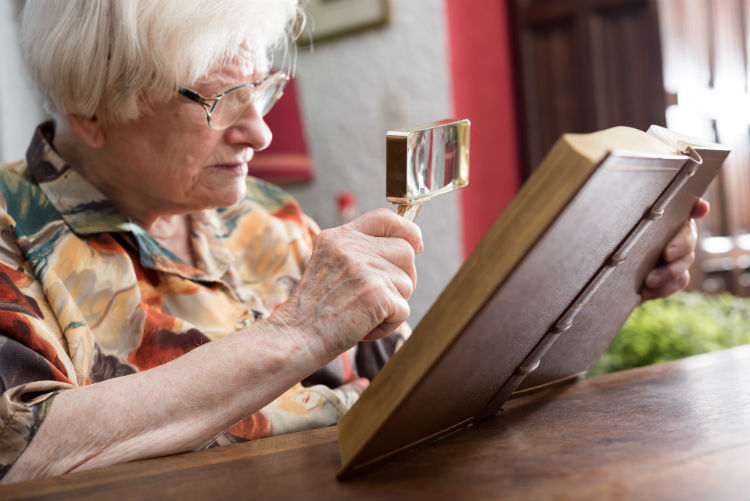Many people would consider losing their eyesight one of the worst losses they could endure. While most of us will not suffer from complete blindness, millions currently live with some form of visual impairment.
According to the National Eye Institute (NEI), older adults represent the majority of the visually impaired population in the United States. While vision loss later in life is common, it can be particularly difficult for seniors to accept and adapt to as other senses like hearing, smell and taste also tend to weaken with age. Use the following tips to ensure an aging loved one properly cares for their eyes and takes advantage of all resources at their disposal to help them remain active in spite of vision loss.
Keeping an Eye on Visual Health
One of the first steps to leading a safe and active life with impaired vision is understanding the degree and underlying cause of this loss.
The American Academy of Ophthalmology recommends individuals age 65 and older get a dilated medical eye exam every year or two, or as recommended by their ophthalmologist. During a routine eye exam, the ophthalmologist will evaluate a patient’s eyesight and assess the overall health and function of both eyes. Screening for new or worsening eye conditions and maintaining a current prescription for eyeglasses and/or contacts are crucial for optimal visual function at any age.
For most people, vision loss is a very gradual process, so seniors (and their family members) may not be aware of how compromised their eyesight has become. Caregivers can help keep tabs on a loved one’s vision by looking for an increase in:
- Squinting or tilting their head when trying to focus.
- Bumping into things or knocking objects over.
- Discontinuing everyday vision-based activities like reading or writing.
- Missing objects when reaching for them.
- Falling or walking hesitantly.
If a loved one is still driving, an increase in accidents and risky maneuvers may also indicate visual changes. It is important to discuss these noticeable changes with your loved one and make an eye appointment to ensure early detection and treatment of any eye diseases and prevent lasting damage.
Helping a Senior Accept Visual Changes
Eye diseases like macular degeneration, cataracts, glaucoma and diabetic retinopathy can have a significant impact on a senior’s functional abilities and quality of life. For some, impaired vision may even result in depression, withdrawal and inactivity.
According to Pris Rogers, program manager of VisionAware.org, an informational website for individuals living with vision loss, caregivers are often equally confused and overwhelmed by their loved ones’ visual changes. They do not know where to turn or how to help their elders who are struggling to accept new limitations.
“Many older adults believe that there is no way they can cope with this loss, since it affects almost all aspects of daily life,” Rogers explains. “But, caregivers and persons with visual impairment need to know that there is hope, and life, after vision loss.”
Tips and Products for Helping a Senior with Low Vision
It is best for caregivers to learn as much as possible about their care recipients’ visual condition and the limitations they experience. This information will help you suggest appropriate modifications to their environment and behavior as well as products that can enhance their functional abilities.
While individual conditions affect eyesight differently, the following tips are an excellent starting point for helping a blind or visually impaired senior safely maintain their independence.
Good Lighting is Key
Keep surroundings well-lit but be mindful of glare. Use specialized lamps/bulbs to increase contrast and reduce glare and cover reflective surfaces when possible. Ensure that appropriate lighting is provided for all activities your loved one engages in. For example, direct task lighting is best for things like reading, playing cards or crafting. Consider a small gooseneck or clip-on lamp for these tasks. Under-counter lighting is another type that works well for illuminating the kitchen and other larger work areas.
Avoid large discrepancies in lighting, such as a bright lamp shining into a dark room. As task lighting is increased, the surrounding room lighting should also be increased. Keeping lights on during daytime hours helps to equalize lighting from both indoor and outdoor sources.
Take Steps to Minimize Fall Risks
Use nightlights in bedrooms, hallways and bathrooms to reduce the risk of tripping and falling at night. Eliminate clutter and remove hazards such as throw rugs and electrical cords. Consider replacing or relocating short or difficult to see furniture, such as a glass coffee or side table. Create wide, clear and level walking paths that lead to all areas of the home for easy and safe navigation.
You may have to reposition some furnishings to make the home easier to navigate. This can be disorienting initially, so make sure to provide your loved one with extra assistance getting around until they have memorized the new layout. Larger-scale rearrangements may be inadvisable for some seniors, especially those with memory issues.
Improve Household Organization
Designate spots for commonly used items and be sure to return objects to the same place every time so that your loved one always knows where things are. Sometimes using a basket to store like objects can make it easier to find things like keys, remotes to electronics and other items.
Combining tactile and visual systems can help seniors more easily navigate their environment, too. Tactile systems are helpful for those with limited or no vision, or for those whose visual abilities change from day to day. An example of a tactile system is placing rubber bands, felt, raised plastic dots or sandpaper cutouts on items to mark their placement or differentiate similar objects. Visual systems make use of any remaining vision to identify and organize things. Common examples include large labels or colored stickers or tapes to differentiate individual items or identify collections of items.
Embrace Contrasting Colors
The juxtaposition of light and dark colors can make daily activities much easier for a person who still has some remaining vision. Like colors can make it difficult for those with visual impairments to detect doorways, stairs and furniture and especially smaller objects that blend into their surroundings.
For example, providing a white cuttingboard for preparing darker foods like apples and a dark board for lighter foods like onions can help extend independence and promote safety. This concept especially applies in settings like bathrooms, which tend to be monotone. Choose towels, washcloths and bath mats that contrast sharply with the color of the tub/shower, counters and flooring. Painting door jambs a contrasting color and using brightly colored tape to highlight the edges of steps are other modifications that can be used to improve safety in the home.
Think Bigger
Magnification is an essential tool for those with low vision, and magnifying devices range from very simple to technologically advanced. Look for items that come with larger print/buttons, such as books, checkbooks, calendars, calculators, remote control units, clocks, watches, appointment books and playing cards.
For items that do not come in low-vision versions, magnifiers can be very helpful. Electronic magnification units use a camera to capture an image and project it onto a built-in monitor, a television screen or a computer screen. These units can be used to read bills and write checks, read books, look at photos, and complete intricate tasks like filling an insulin syringe. Available through low vision supply companies, they can be chosen with preference for image size, degree of contrast, and color or black and white. They range in size from large models to small portable devices. For more technologically savvy seniors, adaptive equipment, such as screen enlargement software, large-lettered keyboards and near telescopic systems are available to facilitate computer use.
Work with a Low Vision Specialist
Low vision specialists have the knowledge and experience to devise personalized solutions for a visually impaired individual's specific needs. Vision rehabilitation can help with mobility training as well as methods of organizing, marking and labeling household items. These specialists are also familiar with resources for obtaining low vision aids and can instruct their clients on how to use them properly. Many vision rehabilitation programs even offer mental health services to help participants cope with the anxiety or depression that often accompanies vision loss.
Provide Moral Support
It’s important to create a strong support system for those with new or worsening visual impairments. Encourage your loved one to remain active with their friends and stick with the hobbies and pastimes they enjoy. Offer to accompany or assist them with these things so they can be more confident in their ability to participate.
Encourage open and honest communication as well. Some people with low vision experience hallucinations known as Charles Bonnet syndrome (CBS). This is often confused with dementia but is very different. Although these hallucinations are harmless, they can be unsettling. Let your loved one know they can talk to you about new symptoms and if something seems to be amiss.
Seniors often worry that sight impairments will affect their ability to live independently. Put your loved one at ease by suggesting resources that will allow them to remain independent, and help them implement the tips above to improve their ability to complete day-to-day tasks on their own.

